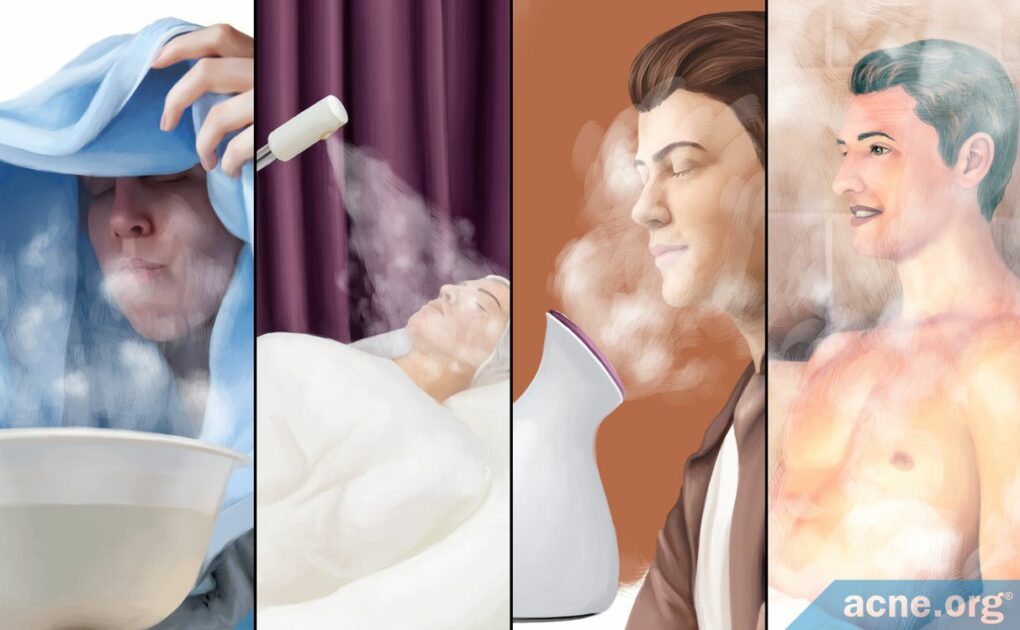Heat and Humidity Often Worsen Acne, So Steaming May Do the Same

The Essential Info
Steaming is a wellness practice that exposes the skin to hot, humid air.
While no research has directly tested steaming on acne-prone skin, multiple studies have looked at how acne responds to hot, humid weather. The results are mixed: many people develop worse acne, a few people’s acne improves, and still others experience no change.
Scientists speculate that steaming might theoretically both increase and decrease acne, for different reasons. However, a larger body of evidence supports the prediction that steaming might make acne worse. Until studies test facial steaming on people with acne, trying the procedure will be a gamble. Chances are you that will experience either a worsening or no change in acne symptoms.
If you still want to try steaming, apply any topical acne treatments immediately after steaming. Scientists speculate that steaming might make the skin better at absorbing medication.

The Science
- The Evidence Is Mixed on Whether Acne Worsens in Hot and Humid Weather
- Side Effects of Steaming
- Theories on How Steam Impacts Acne
- The Bottom Line
Steaming the skin is a wellness practice that harks back to the ancient Greek and Roman baths.1 Advocates of the practice believe that exposing the face to hot steam not only refreshes and relaxes, but also provides health benefits. While some benefits like increased blood flow have been scientifically verified, others, like the idea that steam deep-cleanses the skin, are unsupported by evidence so far.2-4
When it comes to acne, no studies have directly tested how steaming impacts acne-prone skin. However, we know that steaming places the skin in conditions of high heat and humidity. Research on acne in hot, humid environments has yielded conflicting results: many people’s acne gets worse, for a few, acne gets better, and for some people, no change occurs one way or the other. From a theoretical standpoint, there are reasons why steaming might increase acne and also reasons why it might decrease acne. For now, trying facial steaming for acne-prone skin is a gamble that is unlikely to help and might actually make your symptoms worse.
There are several ways of performing facial steaming:
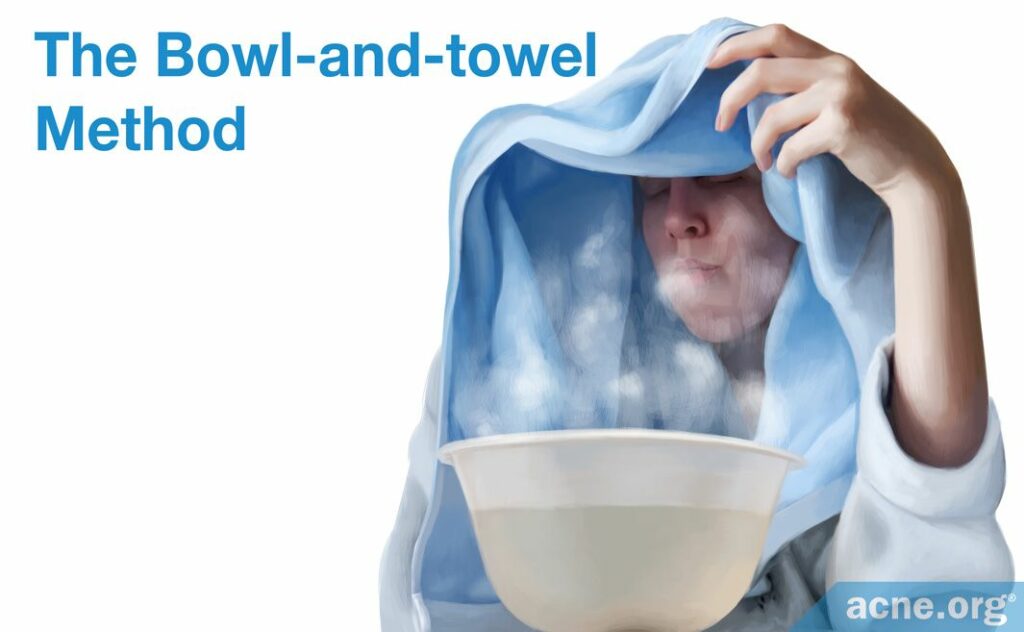
- The bowl-and-towel method: The simplest way to steam your face at home is to stand over a bowl or sink of hot water with a towel draped over your head to keep the steam from escaping.5
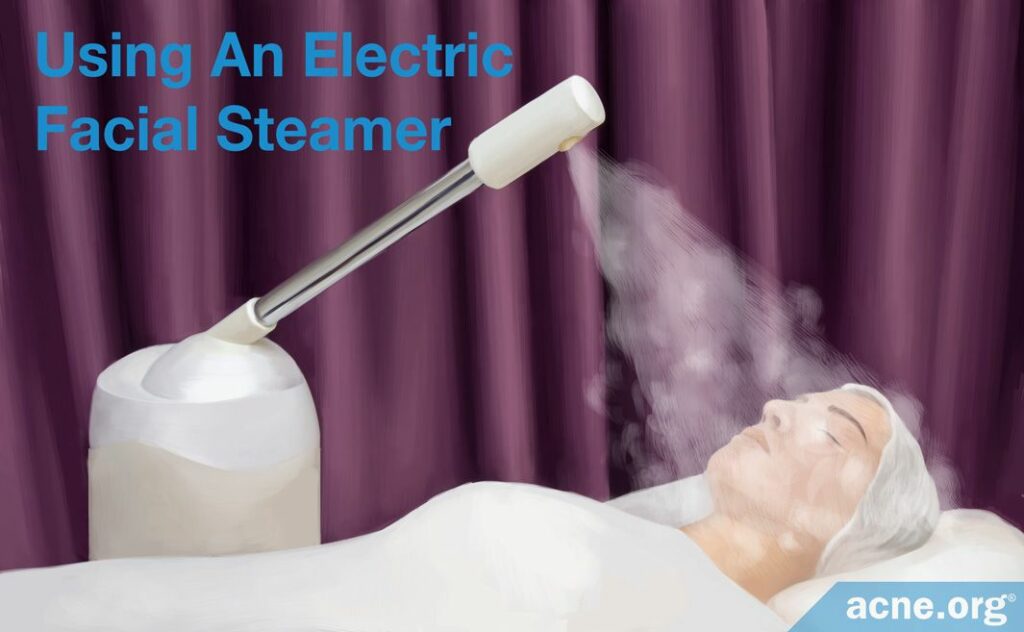
- Using an electric facial steamer: A fancier way to steam your face at home is to purchase an electric facial steamer, which offers a more powerful steam than the bowl-and-towel method.
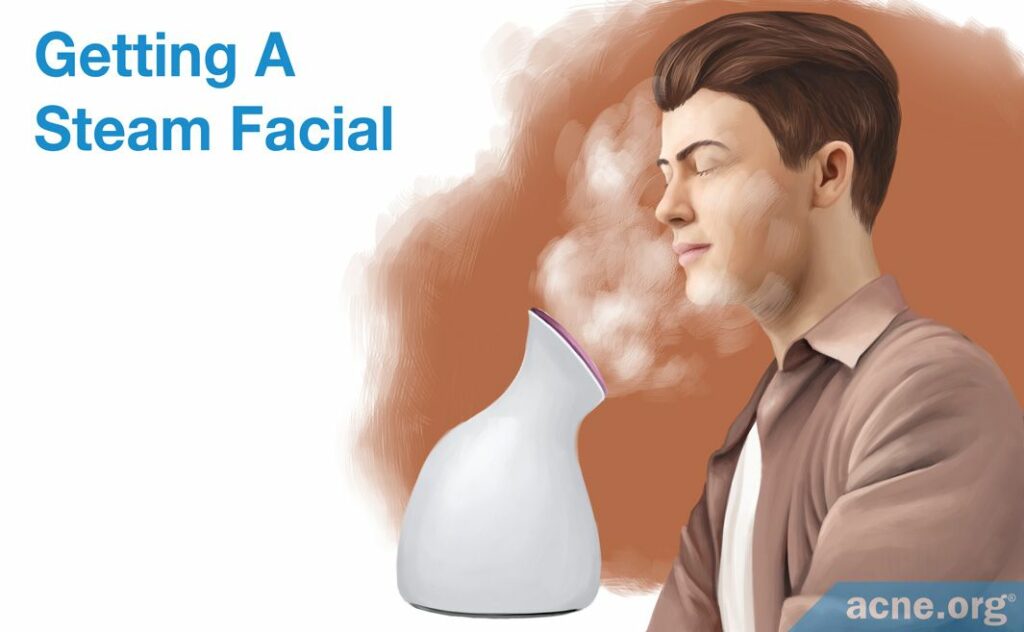
- Getting a steam facial: Another way to steam your face is by getting a steam facial at a spa, where an esthetician will perform the treatment.
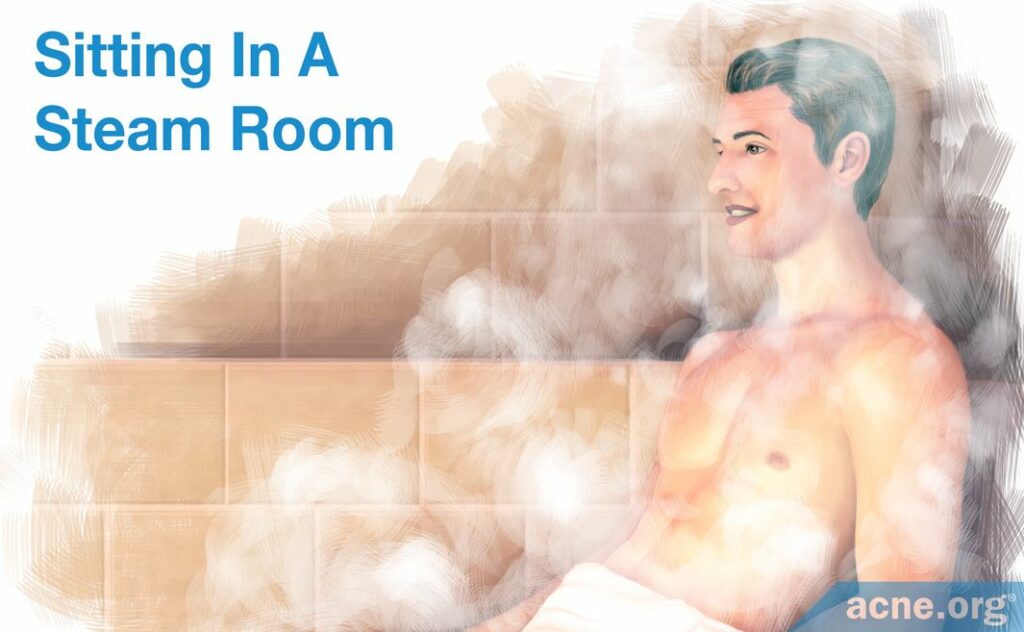
- Sitting in a steam room: This ancient method steams not just your face, but the entire body as you sit in an enclosed space pumped full of steam.
No studies have directly tested the effect of facial steaming on acne. Therefore, anybody who claims that steaming is proven to clear acne is stretching the facts.
However, multiple studies have looked at whether acne worsens or improves in a tropical climate. This type of climate means high temperatures and high humidity. In other words, spending time outdoors in a tropical climate can feel like hanging out in a steam room. Let’s take a look at research showing that acne may either worsen or improve in such conditions.
The Evidence Is Mixed on Whether Acne Worsens in Hot and Humid Weather
In the mid-twentieth century, doctors noticed that American military members serving in tropical zones often developed acne. They even coined the term “tropical acne” to describe this phenomenon. At the time, doctors speculated that heat may stimulate skin oil glands to produce too much skin oil.6 Overproduction of skin oil, in turn, is a well-known early step in pore clogging and the development of acne.7
This early theory that tropical weather triggers acne suggests that steaming your face might also trigger acne. However, subsequent research has poked some holes in this theory. While some studies have found a worsening of acne with heat and humidity, others have seen no effect of weather one way or the other. In other words, based on the research evidence, it’s difficult to say for sure whether acne worsens in hot and humid weather. By extension, it’s also difficult to say whether steaming your face is likely to worsen your acne or have no effect.
Studies on acne in hot and humid weather
Three studies, looking at a total of 680 patients, have investigated whether acne increases in high heat and humidity, with mixed results.
Study 1: In the first study, researchers interviewed 452 Indian patients with acne to determine whether their acne got better or worse in the summer. Only about half of the patients had noticed any seasonal changes in their acne. Of these, 56% experienced a worsening of acne in the summer, while 16.7% noticed an improvement in the summer. According to the study authors, most of the patients who experienced worse acne in the summer “believed that the summer aggravation was due to sweating and increased humidity.”8 This study supports the idea that a hot, humid climate might be harmful for acne-prone skin, although each patient may respond differently.
Study 2: In the second study, researchers interviewed 139 German patients with acne about seasonal changes in acne severity. The results were evenly split: approximately a third of patients reported worsening of their acne in the summer, a third reported improvement in the summer, and a third noticed no seasonal changes at all.9 This study would suggest that a person with acne may have equal chances of experiencing a flare-up or a lessening of symptoms in hot, humid weather.
Study 3: In the third study, researchers took various skin measurements in 89 Korean females at different times of the year. For acne, the most interesting measurement was the amount of skin oil. The scientists found that the amount of skin oil increased in the hottest, most humid months of August and September.10 As we have already discussed, more skin oil tends to mean more acne. In other words, this study indirectly suggests that acne might get worse in hot, humid weather.
To sum up, these three studies came to somewhat conflicting conclusions. Two of the studies concluded that hot, humid summer weather might tend to worsen acne. One study found no seasonal pattern at all. Since hot, humid weather approximates the conditions of steaming, this means the jury is still out on whether steaming would tend to worsen acne or have no effect one way or the other.
The table below recaps the results of the three studies.
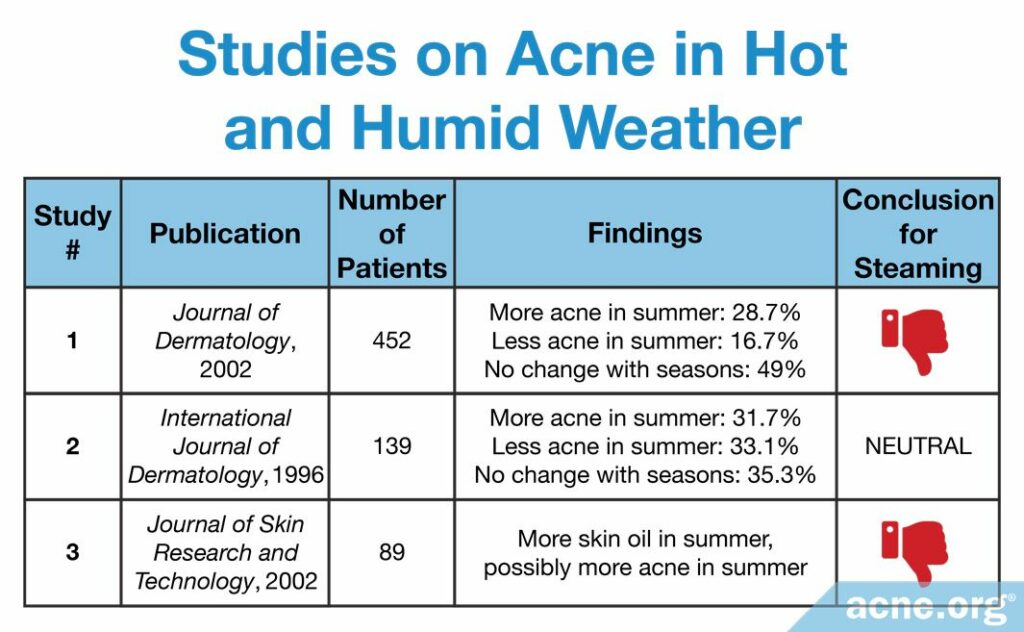
Expand to reveal more details of these 3 studies
Study 1:

This study was published in the Journal of Dermatology in 2002. The researchers interviewed 452 Indian acne patients between the ages of 15 and 23. The patients included 220 males and 232 females. 49% of the patients experienced no seasonal changes in acne. Of the remaining patients, 56.3% noticed a worsening of acne in summer, while 16.7% experienced the opposite. Lastly, 63 patients (27.5% of those who experienced seasonal fluctuations in acne) sometimes developed worse acne in summer and sometimes in winter.8
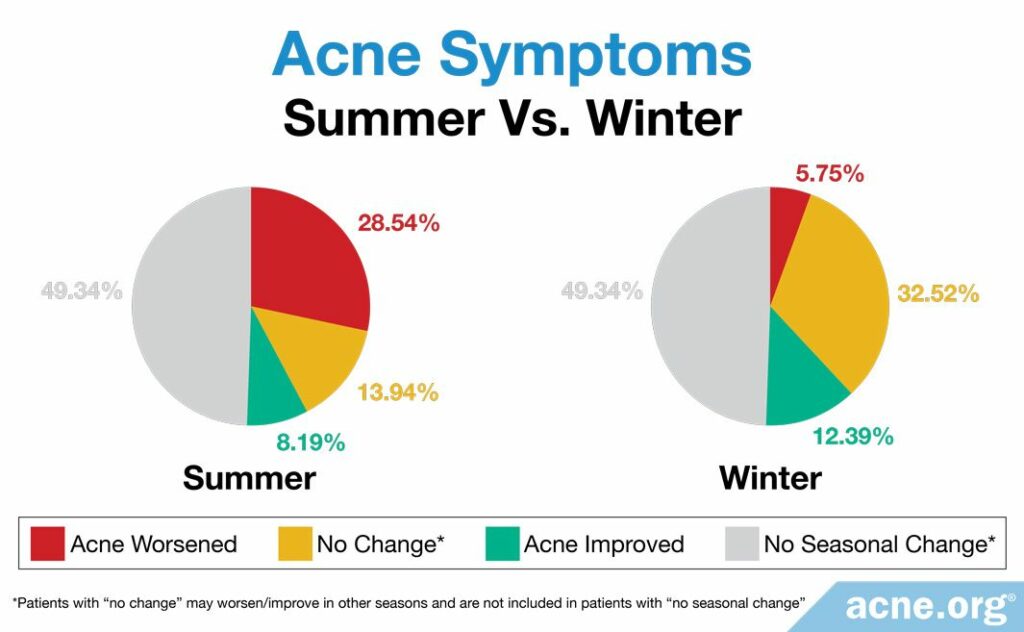
Study 2:

This study was published in the International Journal of Dermatology in 1996. Dermatologists interviewed 56 German men and 83 German women with acne. They found that of the total of 139 patients, 44% complained of worse acne in the summer, while 46% reported an improvement in the summer. Lastly, 49 patients reported no seasonal change. The researchers also checked whether patients with certain forms of acne, such as severe cystic acne, were more likely to experience specific seasonal changes. However, they concluded that “[t]here was no striking difference in seasonal response among the different types of acne.”9
Study 3:

This study was published in the Journal of Skin Research and Technology in 2015. The researchers tested the skin of 89 Korean females every month for 13 months. They took measurements of skin oil, skin moisture, scales, brightness, and elasticity. The scientists found that the highest air temperature and humidity, which occurred between August and September, coincided with increased skin oil excretion. The increased skin oil was particularly noticeable on the forehead.10 We should note that the temperature and humidity during these two months in Korea closely approximates the temperature and humidity during steaming.
Side Effects of Steaming
While no studies have directly looked at steaming for acne, researchers have tested steaming the face as a treatment for the common cold. The side effects of this treatment may include:
- For all patients: The main risk of steaming is the possibility of accidentally scalding the skin.
- For patients with rosacea: Steaming may worsen skin redness by widening blood vessels under the skin.
- For patients with dry skin and eczema: Steaming may worsen skin irritation and itchiness.11
Theories on How Steam Impacts Acne
As we have seen, steam-like conditions seem to aggravate acne in many cases, although some people experience no change or, occasionally, even an improvement. Scientists have advanced various theories to explain how steam might increase or decrease acne. If you are curious, read on as we explore these ideas.
First, we’ll take a look at explanations for how steaming might be harmful for acne-prone skin.
Reasons why steaming might worsen acne
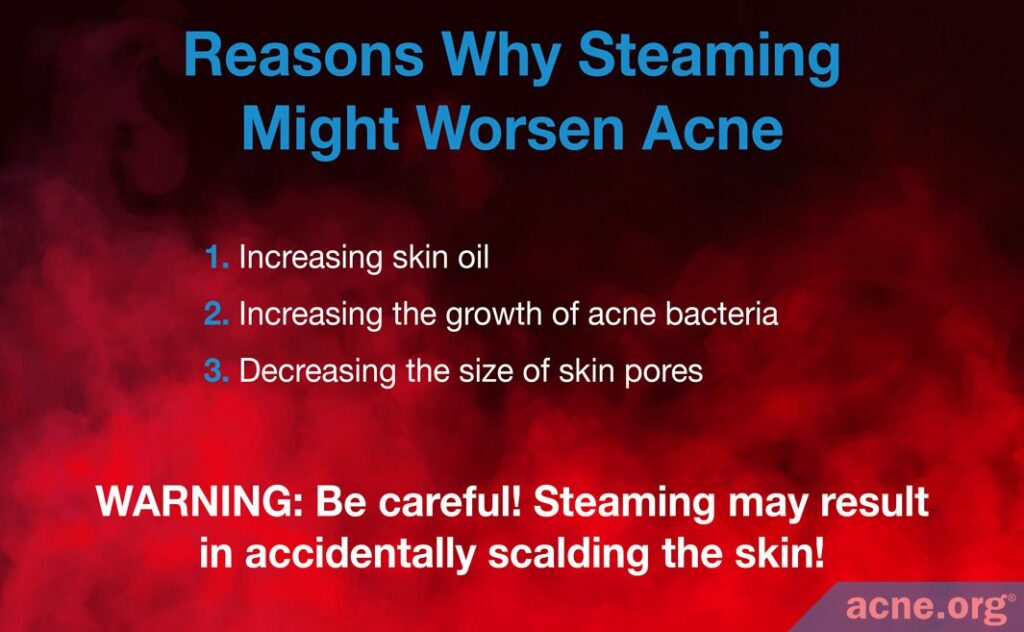
Scientists speculate that steaming might increase acne in 3 possible ways:
- Increasing skin oil: Heat and humidity may stimulate the skin to produce more skin oil, leading to a higher risk of pore clogging and acne.
- Increasing the growth of acne bacteria: By stimulating more skin oil production, steaming may create favorable conditions for the overgrowth of acne bacteria, which contribute to acne.
- Decreasing the size of skin pores: By swelling the skin cells that line skin pores, steaming might shrink the pores, making them more likely to clog. Clogged pores can later turn into acne lesions.8,12-16
Let’s take a look at evidence supporting these possibilities.
1. Evidence that steaming might increase skin oil production
Three studies provide evidence that steaming, which exposes the skin to high temperature and humidity, stimulates increased skin oil production.
Study 1: In the first study, researchers performed an experiment on 9 volunteers. They heated the skin of the volunteers’ foreheads and measured the amount of skin oil on the skin surface. They found that within 90 minutes of heating, the amount of skin oil increased significantly.13
Study 2: In the second study, researchers measured the amount of skin oil on the face in 46 Korean females in each of the four seasons. They found the highest amount of skin oil in the summer, which corresponds to the hottest and most humid time.14 This suggests that steaming, which also exposes the skin to heat and humidity, would similarly increase skin oil production.
Study 3: In the third study, scientists examined the effect of high temperature and humidity on the skin of 440 healthy Chinese women. The researchers found that during summer, a time of high heat and humidity, the women experienced a significant increase in skin oil production. The study authors wrote, “[skin oil] is secreted more in a hot climate during summer, thereby causing very oily skin.”15
To sum up, all three studies indicate that steaming should increase skin oil production, which in turn may lead to pore clogging and breakouts. However, we should note that these studies tested the longer-term effects of heat and humidity: 90 minutes in the first study and season-long exposures in the second and third studies. In comparison, steaming is typically performed for only 5-20 minutes.1 Therefore, it is possible that such a short exposure might not noticeably increase skin oil production and thus might have no effect on acne.
Expand to reveal more details of these 3 studies
Study 1:

This study was published in the British Journal of Dermatology in 1970. The researchers heated one side of each volunteer’s face to 38.3-39.4°C while leaving the other side at room temperature. Within 90 minutes, the heated side showed a higher skin oil excretion rate compared to the non-heated side. The researchers speculated that heat made skin oil runnier, therefore causing it to “spill out” from skin pores more quickly.13
Study 2:

This study was published in the Journal of Skin Research and Technology in 2005. The researchers used a Sebumeter to measure facial skin oil levels in 46 Korean females in each season. They found similar skin oil levels in autumn, winter, and spring, but significantly increased skin oil levels in the summer.14
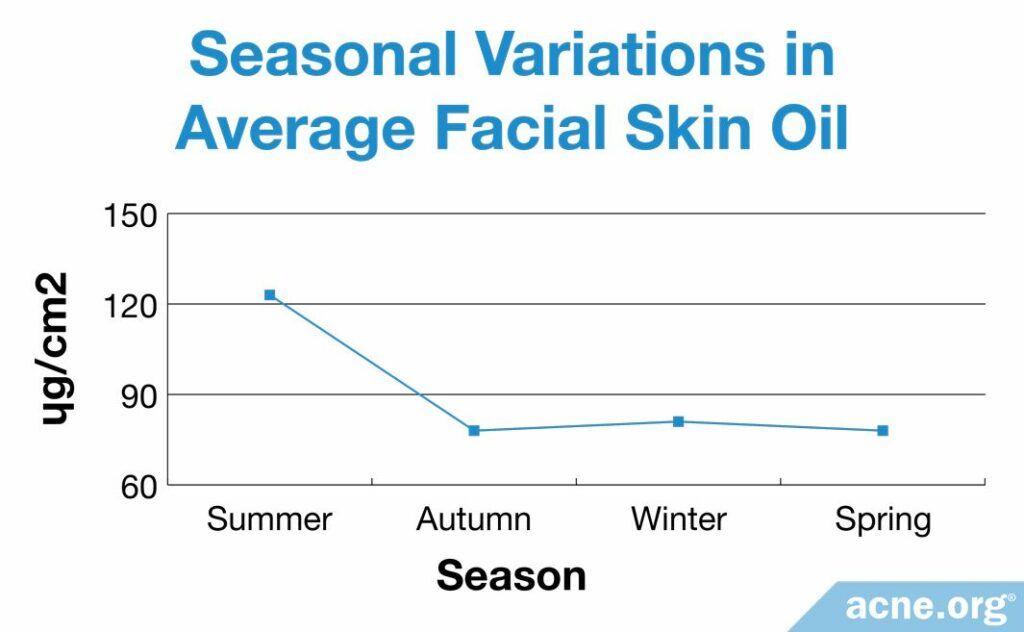
Study 3:
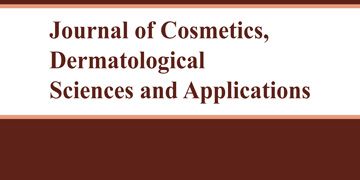
This study was published in the Journal of Cosmetics, Dermatological Sciences and Applications in 2017. The researchers evaluated the effects of climate on the skin of 440 healthy Chinese women from Beijing and Guangzhou. Beijing has mean temperatures around 26.3°C and 64.5% humidity in the summer, while Guangzhou has mean temperatures of 28.7°C and 74.9% humidity. In both cities, women experience a significant increase in sebum excretion in the summer.15
2. Evidence that steaming might increase the growth of acne bacteria
Acne bacteria, also known as C. acnes (Cutibacterium acnes), are bacteria present in/on most people’s skin. The bacteria can be harmless, but if they overgrow, they may contribute to clogged pores and also trigger inflammation, both of which make acne worse.7
Only one study provides indirect evidence that steaming might lead to overgrowth of these acne bacteria. In this study, researchers measured the amount of skin oil on the faces of 30 healthy female volunteers and also looked for bacteria on the volunteers’ skin. They found that females with higher levels of skin oil tended to have more C. acnes on their skin.16
Earlier, we looked at evidence that steaming may increase skin oil production. This study suggests that the next step may be overgrowth of acne bacteria, leading to a worsening of acne. This might be another reason why some people experience an increase in acne in hot, humid weather or after steaming.
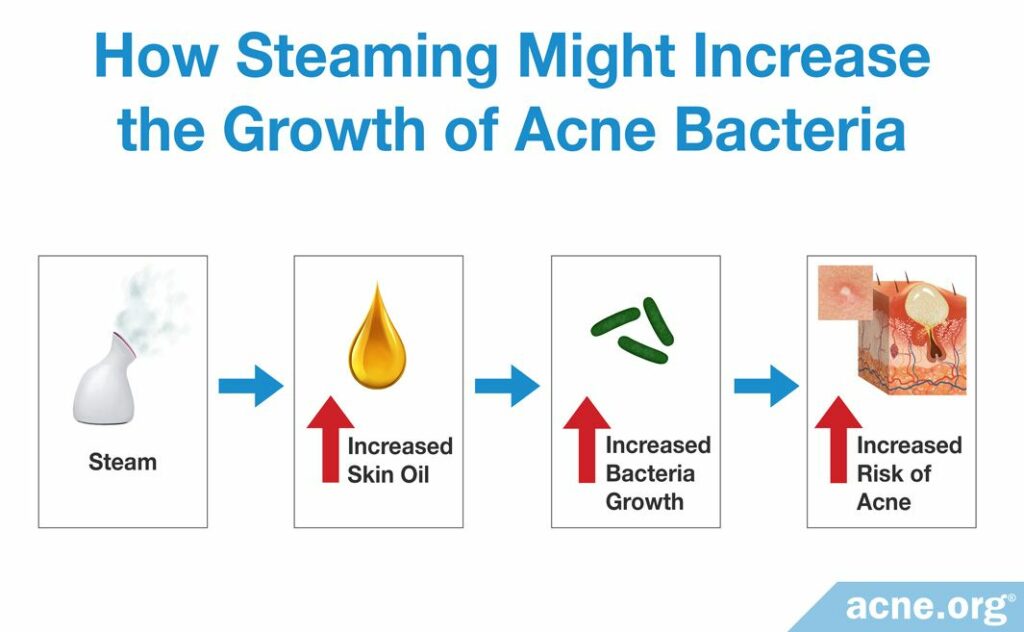
Expand to reveal more details of study

This study was published in the journal Scientific Reports in 2016. The researchers measured skin oil amounts on the forehead and cheek of 30 healthy females. In addition, they used gene sequencing to identify the types of bacteria present in these skin regions. The most common type of bacteria was Cutibacterium , followed by Staphylococcus, Streptococcus, and Corynebacterium. The scientists found that increased skin oil on the cheek was a good predictor of increased numbers of Cutibacterium .16
3. Evidence that steaming might decrease skin pore size
Scientists have proposed that steaming might swell the skin cells lining skin pores, making the pores become smaller. Shrunken pores may be more likely to clog, and clogged pores can turn into acne lesions.8
One study provides some evidence that steaming might shrink skin pores. In this study, scientists performed an experiment on 28 volunteers. They exposed the volunteers’ skin to steam for 20 minutes and examined it with a microscope. They found that steam began to shrink the size of skin pores within one minute, and that after 15 minutes, pores had shrunk by half. The researchers speculated that these smaller pores may be more prone to obstruction (clogging). However, they noted that 90 minutes after the steam exposure ended, the pores had almost returned to their original size.12
Expand to reveal more details of study

This study was published in the British Journal of Dermatology in 1974. The volunteers sat in a hot bath, exposing the skin on the back to steam. The skin on the back was never immersed in the bath. The volunteers sat in the 45°C bath for 20 minutes. The researchers used a surface microscope to measure the diameter of skin pores.12
To sum up, scientists have come up with three possible explanations for how steaming might worsen acne. Now let’s take a look at some ideas on how steaming might actually improve acne.
Is there any chance steaming might improve acne?
Scientists speculate that steaming might decrease acne in 3 possible ways:
- Improving absorption of topical acne treatments: Heat and humidity might theoretically make the skin more penetrable, allowing easier absorption of topical acne drugs.
- Decreasing inflammation: Heat increases blood flow to the skin, and in theory, this might help reduce inflammation. Since inflammation is at the core of acne, reducing inflammation may help control the disease.
- Decreasing growth of new skin cells: The humidity in steam might potentially slow down the overgrowth of new skin cells that often occurs in acne. Since excess skin cells tend to clog pores, this might help to reduce the risk of pore clogging.9,17-20
Let’s take a brief look at the indirect evidence supporting these possibilities.
- Evidence that steaming might improve absorption of topical acne treatments
Two lab studies have found that exposing skin samples to high heat and humidity makes the skin more permeable. In these experiments, raising humidity from 50% to 100% led to a tenfold increase in skin permeability.18,19 Steaming exposes the skin to approximately 100% humidity.1 This suggests that steaming might also make the skin more penetrable, which would allow better absorption of any topical acne treatments applied right after steaming. However, this is only a theoretical idea that needs to be tested on patients. - Evidence that steaming might decrease inflammation
The evidence supporting this idea is very preliminary and indirect. Research on another skin disorder called atopic dermatitis shows that low temperature and low humidity may increase inflammation.17 Theoretically, high temperature and high humidity, such as occurs in steaming, might achieve the opposite. Decreasing inflammation may help improve acne, which is an inflammatory condition.7 However, the idea that steaming might decrease inflammation is largely hypothetical and requires direct testing. - Evidence that steaming might decrease growth of new skin cells
In acne, skin cells tend to overgrow and clog skin pores. Some research in animals suggests that in high humidity, the growth of new skin cells slows down.20 Since steaming creates conditions of high humidity, it might achieve the same effect. Slowing down the growth of new skin cells might reduce the risk of pore clogging and therefore might improve acne. However, this is a purely theoretical idea that requires testing on patients.
The Bottom Line
Steaming the face exposes the skin to hot, humid air, which might worsen acne or have no effect one way or the other. Until researchers directly test steaming on people with acne, this folk treatment will remain risky.
References
- Bergel RR. Steam Bath. http://www.sld.cu/galerias/pdf/sitios/rehabilitacion-bal/steam__bath.pdf. Accessed June 17, 2019.
- Shiralkar V V, Jagtap PE, Belwalkar GJ, Nagane NS, Dhonde SP. Effect of Steam Sauna Bath on Fasting Blood Glucose Level in Healthy Adults. Indian J Med Biochem. 2018;22(1):18-21. doi:10.5005/jp-journals-10054-0047 https://www.researchgate.net/publication/326203347_Effect_of_Steam_Sauna_Bath_on_Fasting_Blood_Glucose_Level_in_Healthy_Adults
- Iwase S, Kawahara Y, Nishimura N, et al. Effects of dry and mist saunas on circulatory and thermoregulatory functions in humans. 2013;5(2):267-273. doi:10.4236/health.2013.52036 https://www.scirp.org/journal/paperinformation.aspx?paperid=28448
- Roberts MF, Wenger CB. Control of skin circulation during exercise and heat stress. Med Sci Sports. 1979;11(1):36-41. http://www.ncbi.nlm.nih.gov/pubmed/481154. Accessed August 10, 2019.
- Sensio Spa. Complete Hydrotherapy Facial A Five Step Routine Instruction Manual. https://www.sensiospa.com/wp-content/uploads/2015/07/Sensio-Spa-Hydrotherapy-Steamer-IM.pdf. Accessed July 23, 2019.
- Novy FG. Tropical Acne. Vol 65.; 1944. https://www.ncbi.nlm.nih.gov/pmc/articles/PMC1642718/pdf/califmed00330-0012.pdf. Accessed June 16, 2019.
- Fox L, Csongradi C, Aucamp M, Du Plessis J, Gerber M. molecules Treatment Modalities for Acne. 2016. doi:10.3390/molecules21081063 https://www.ncbi.nlm.nih.gov/pubmed/27529209
- Sardana K, Sharma RC, Sarkar R. Seasonal variation in acne vulgaris–myth or reality. J Dermatol. 2002;29(8):484-488. http://www.ncbi.nlm.nih.gov/pubmed/12227481. Accessed June 16, 2019.
- Gfesser M, Worret W. Seasonal variations in the severity of acne vulgaris. Int J Dermatol. 1996;35(2):116-117. doi:10.1111/j.1365-4362.1996.tb03274.x https://pascal-francis.inist.fr/vibad/index.php?action=getRecordDetail&idt=3127475
- Nam GW, Baek JH, Koh JS, Hwang J-K. The seasonal variation in skin hydration, sebum, scaliness, brightness and elasticity in Korean females. Ski Res Technol. 2015;21(1):1-8. doi:10.1111/srt.12145 https://www.ncbi.nlm.nih.gov/pubmed/24528115
- Baartmans M, Kerkhof E, Vloemans J, Dokter J, Nijman S. Steam inhalation therapy : Br J Gen Pract. 2012;(July):473-477. doi:10.3399/bjgp12X652337.e473 https://www.ncbi.nlm.nih.gov/pmc/articles/PMC3481493/
- Williams M, Cunliffe WJ, Gould D. Pilo-sebaceous duct physiology. Effect of hydration on pil-sebaceous duct orifice. Br J Dermatol. 1974;90(6):631-635. doi:10.1111/j.1365-2133.1974.tb06691.x https://createdbychitra.wordpress.com/2017/03/30/overhydration-as-a-cause-of-acne/
- Cunliffe WJ, Burton JL, Shuster S. The effect of local temperature variations on the sebum excretion rate. Br J Dermatol. 1970;83(6):650-654. doi:10.1111/j.1365-2133.1970.tb15759.x https://onlinelibrary.wiley.com/doi/abs/10.1111/j.1365-2133.1970.tb15759.x
- Youn SW, Na JI, Choi SY, Huh CH, Park KC. Regional and seasonal variations in facial sebum secretions: a proposal for the definition of combination skin type. Ski Res Technol. 2005;11(3):189-195. doi:10.1111/j.1600-0846.2005.00119.x https://www.ncbi.nlm.nih.gov/pubmed/15998330
- Kim E, Han J, Park H, et al. The Effects of Regional Climate and Aging on Seasonal Variations in Chinese Women’s Skin Characteristics. J Cosmet Dermatological Sci Appl. 2017;07(02):164-172. doi:10.4236/jcdsa.2017.72014 https://www.scirp.org/journal/paperabs.aspx?paperid=77089
- Mukherjee S, Mitra R, Maitra A, et al. Sebum and Hydration Levels in Specific Regions of Human Face Significantly Predict the Nature and Diversity of Facial Skin Microbiome. Sci Rep. 2016;6(1):36062. doi:10.1038/srep36062 https://www.nature.com/articles/srep36062
- Engebretsen KA, Johansen JD, Kezic S, Linneberg A, Thyssen JP. The effect of environmental humidity and temperature on skin barrier function and dermatitis. J Eur Acad Dermatology Venereol. 2016;30(2):223-249. doi:10.1111/jdv.13301 https://www.ncbi.nlm.nih.gov/pubmed/26449379
- Park J-H, Lee J-W, Kim Y-C, Prausnitz MR. The effect of heat on skin permeability. Int J Pharm. 2008;359(1-2):94-103. doi:10.1016/j.ijpharm.2008.03.032 https://www.ncbi.nlm.nih.gov/pubmed/18455889
- Fritsch WC, Stoughton RB. The Effect of Temperature and Humidity on the Penetration of c’4 Acetylsalicylic Acid in Excised Human Skin. Vol 41.; 1963. doi:10.1038/jid.1963.115 https://www.ncbi.nlm.nih.gov/pubmed/14075455
- Denda M, Sato J, Tsuchiya T, Elias PM, Feingold KR. Low Humidity Stimulates Epidermal DNA Synthesis and Amplifies the Hyperproliferative Response to Barrier Disruption: Implication for Seasonal Exacerbations of Inflammatory Dermatoses. J Invest Dermatol. 1998;111(5):873-878. doi:10.1046/j.1523-1747.1998.00364.x https://www.ncbi.nlm.nih.gov/pubmed/9804352
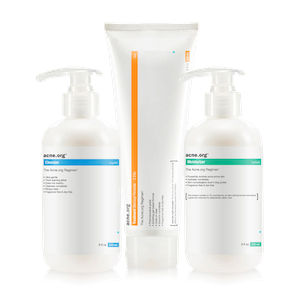 Acne.org Products
Acne.org Products